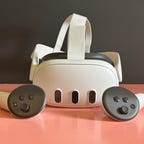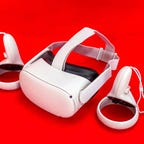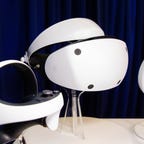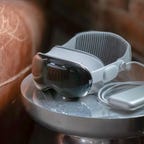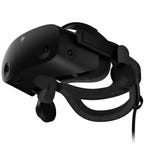 Why You Can Trust CNET
Why You Can Trust CNET Best VR Headset of 2024
Our top picks for VR headsets this year, including the Meta Quest 3 and Quest 2, Sony PSVR 2 and thoughts on the Apple Vision Pro, all tested by CNET.
What's the best VR headset overall?
VR is transforming, and that’s only partially because of Apple. The terms “VR” and “AR” are being folded together into mixed reality thanks to a wave of VR headsets that also have passthrough cameras to blend the virtual and real. The most affordable mixed reality headset you can buy right now is the Meta Quest 3: at $500, it’s $250 more expensive than the Quest 2, but $3,000 less expensive than the Apple Vision Pro.
The Quest 3 has a newer, fasterSnapdragon XR2 Gen 2 processor that has better graphics and a higher-res display than the Quest 2, better lenses and redesigned controllers, and it can also blend the virtual and real world with passthrough color cameras, but Apple's headset beats it on display and camera fidelity. The Quest platform has plenty of side benefits: it has hundreds of games and creative/productivity apps, has several great fitness programs for effective cardio workouts, can connect to PCs and can even double as a work device if you have some patience. It also has hand tracking that works without controllers, but controllers are included to give you two options for input. The Quest 3 can even play iPhone 15 Pro-shot “spatial” 3D videos, too.
The Apple Vision Pro is an amazing piece of tech and a bleeding-edge high-end mixed reality headset that also runs iOS and thousands of iPad apps, works without controllers using eye and hand tracking and can run multiple apps at the same time, along with being a virtual MacBook monitor. The 4K micro-OLED displays are stunning, and videos and photos look fantastic. Apple’s device requires a tethered battery pack, is only made to work within Apple’s ecosystem and doesn’t have many unique apps yet at launch that do more than act as floating 2D screens. The Vision Pro could very well be the start of a whole new chapter in headsets, and may turn into the best product in this whole category over time, but not right now for most people. At its current price and software limits, you’re better off waiting and trying a free demo instead. The Quest 3 is a far cheaper ticket to explore similar ideas in the meantime at a huge discount.
At CNET, we've been testing and reviewing VR/AR headsets since the arrival of the original Oculus Rift prototypes. We've covered nearly every big moment in the industry for well over a decade and have demoed every headset we could get our hands on, as well as reviewed all the biggest products in the marketplace. Our comparative understanding of the landscape, and also what's coming, lets us value the present in terms of the future.
Best VR headsets of 2024
Like
- Crisp high-res displays
- Improved new processor
- Mixed reality with better color cameras
- Smaller controllers with better haptics
Don't like
- More expensive than Quest 2
- Few unique apps and games at launch
- Straps and comfort still aren't great
- Still only 2-3 hours battery life
Meta's upgraded VR sequel to the Quest 2 feels like a notable revamp, with improvements across the board: a slightly smaller design, better, clearer lenses, a higher-res display, smaller controllers with better haptics and higher-res color cameras that can mix the real world and the virtual together. This "mixed reality" is similar in spirit to what Apple's Vision Pro will do but in a lower-res form for a lot less money.
Even though the Quest 3 has great upgrades, it doesn't really change the equation much on the general way the headset and software function. Quest apps and the OS are largely the same, and mixed reality is mostly a gimmick for the moment that's only featured in a handful of new games and apps, although seeing your surroundings with the headset on (and even checking messages on your phone) is a lot easier now. The headset's comfort level isn't any better, and hand tracking still is fine but not perfect.
The Quest 3 is likely to be the best VR headset in its price class for the next few years, but the software still hasn't caught up. For that reason, the Quest 2 is still probably good enough for most. Its excellent display quality and improved wireless connectivity could make it a good choice for PC VR gamers: it works as a connected PC headset just like other Quest models do.
- Display: LCD, 2,064x2,208 pixels per eye
- Eye tracking: No
- Processor: Qualcomm Snapdragon XR2 Gen 2
- Works with glasses: Yes
Like
- High-res display
- Great self-contained gaming experience
- Doubles as PC VR headset
- Works well with a handful of fitness apps
Don't like
- Only 2 to 3 hours of battery life
- Not designed for younger kids
The Quest 2 is still the most affordable and versatile VR headset of the moment. It doesn't require a gaming console or PC (although you need to pair it with a phone to set it up). The newly announced Quest 3 looks like the better product, although it costs more ($500), and we haven't reviewed it yet.
Meta will support the Quest 2 with future software right now, but the Quest 3's more advanced processor will make it more future-proof. For that reason alone, the Quest 3 looks to be worth the extra money. But for those who want an affordable option for families, the Quest 2 remains an excellent pick.
The base model's 128GB of storage is plenty for storing dozens of games and apps, although keep in mind there's no way to add more storage after purchase. Meta also now allows accounts to bypass Facebook logins, although a new Meta account is still required. Meta has also added better parental controls for younger players.
The Quest 2 reminds me of the Nintendo Switch for its versatility and fun, and it has a growing library of surprisingly effective fitness apps. The Quest 2 can also connect with a PC to run more advanced apps from Steam or Meta's own app library, using a single USB-C cable or wirelessly.
- Display: LCD, 1,842x1,920 pixels per eye
- Eye tracking: No
- Processor: Qualcomm Snapdragon XR2
- Works with glasses: Yes
Like
- Vivid, high-res OLED display
- Comfortable fit
- Excellent controllers
- Realistic vibrations
- Powerful graphics potential
Don't like
- Expensive
- Needs to be cabled to PS5
- Included earbuds are just OK
- Doesn't work with old PSVR games
- Game library needs more exclusives
The PSVR 2 is expensive ($550), and needs a PlayStation 5 to even work. It's tethered, not wireless. Its HDR OLED display, graphics quality, built-in eye tracking and fantastic advanced controllers -- which have the same vibrations and adaptive force-feedback triggers as the PS5 DualSense controllers -- give this headset a premium feel that makes its best games perform at a different level. It could be a landing spot for top PC VR games, but right now it already has some exclusives like Gran Turismo 7, Resident Evil Village and Horizon: Call of the Mountain.
The PSVR 2 lacks any social metaverse-type software so far and feels more like a headset designed to just launch and play VR games. Many of the games for this headset are ports of titles you could get on devices like the Quest 2 instead. As more games roll out that are optimized for this hardware, the PSVR 2 could quickly stand out from the standalone VR pack. You might want to wait and see what happens unless you're ready to jump in and trust Sony now.
- Display: OLED, 2,000x2,040 pixels per eye
- Eye tracking: Yes
- Requires tethering to PS5 to work
- Works with glasses: Yes
Like
- Amazing micro-OLED display
- A mostly fluid hand-eye control interface
- Blends the real and virtual worlds impressively
- iOS support folds in tons of familiar apps for work
- Playing back personal 3D memories feels transporting
Don't like
- Extremely expensive
- Hand-eye interface isn't always perfect
- Not many VisionOS optimized apps yet
- External battery and cord required for use
- Doesn't work over glasses
Apple stands alone in the category of "standalone mixed reality computer headset" because, really, nothing else out there does exactly what the Vision Pro does. Most VR headsets to date have focused on games and individual immersive creative and work apps to explore ideas in mixed reality. Apple’s Vision Pro takes a very different path by folding in almost all of iOS. Having familiar Apple services and thousands of iOS apps floating in virtual workspaces feels like a future where our existing devices and VR/AR finally dovetail.
The Vision Pro also has a phenomenal micro-OLED display that plays movies incredibly well. The hand/eye tracking feels futuristic too and, at its best, it’s far more of a mouse/trackpad replacement than Meta’s hand tracking on Quest. Its mixed reality capabilities are the best we’ve ever seen, with passthrough cameras that are the best quality of any standalone device.
The Vision Pro needs more apps to make the most of its potential and lacks many of the games and fitness experiences that Quest offers. As a work device, once some of the early software quirks are ironed out, it’s got incredible promise -- it can act as a surprisingly great virtual monitor for Macs, too. As a fancy travel home theater for someone with $3,499 to spend, it’s also fascinating. At this price, no matter how stunning the experience can be, it’s a product most people should wait on or simply try a demo of first. Keep in mind that the Vision Pro doesn’t work with glasses (you’ll need Zeiss prescription lens inserts, a separate $100-$150 purchase), and the headset has its own tethered battery pack that has to be used along with the device, making it feel less self-contained than the Quest.
- Display: Micro-OLED, unknown specific resolution (Apple states 4K per eye)
- Eye tracking: Yes
- Processor: Apple M2
- Works with glasses: No
Like
- Higher-res display
- Wider field of view
- Great audio
Don't like
- Controllers feel cheap
- No headphone jack
If your idea of the best VR headset is to have the best image quality in consumer VR, HP's Reverb G2 wins. For serious gamers (or VR racing sim fans), it's probably your best choice. The 2,160x2,160-per-eye resolution and 114-degree field of view are the best at this price range, and the lightweight, comfy headset also has fantastic dropdown speakers designed by Valve. It's technically a Microsoft Windows mixed reality headset that prefers to launch into Microsoft's native Windows 10 VR ecosystem, but it bridges with Steam VR and works with those games and apps, too. Built-in camera-based room tracking is easier to set up than the Valve Index's external base stations but is more prone to tracking errors. The included controllers, based on Microsoft's VR controller design, feel clunkier than either the Quest 2 controllers or the Valve Index controllers. Also, the over-ear speakers are your only audio choice; there's no headphone jack.
It lists for $599, but it's often on sale for less.
- Display: LCD, 2,160x2,160 pixels per eye
- Eye tracking: No
- Requires connection to PC to work
- Works with glasses: Yes
Like
- Excellent SteamVR compatibility
- Good audio
- Innovative controllers
Don't like
- Requires external room sensors for tracking
- Display resolution lags behind current headsets
Valve's headset isn't as cutting-edge as it was when it debuted in 2020, but its Steam VR and Vive hardware compatibility, excellent audio and fancy controllers still make it hardware worth considering. Valve's "knuckle" controllers are pressure-sensitive and can track all five fingers, making them almost like gloves. Not all apps make the most of them, but Valve's hardware is mix-and-match compatible with the HTC Vive, which also is built on the Steam VR platform. The Index headset has excellent audio, but its display resolution is no longer as good as competitors'.
The Index also needs external "lighthouse" boxes similar to the HTC Vive for tracking, meaning you need to set those up in a room first. It's not as self-contained as the Quest 2 or HP Reverb G2, which can track the room with in-headset cameras. It's also definitely not wireless, but if you already have some older HTC Vive hardware, you could add on parts of the Index to mix and match. It feels like this hardware could be due for an upgrade sooner than later.
- Display: LCD, 1,440x1,600 pixels per eye
- Eye tracking: No
- Requires connection with PC to work, and external room sensors
- Works with glasses: Yes
Other VR headsets we've tested
Meta Quest Pro: Last year's expensive, eye-tracking-equipped Quest headset can track facial expressions and has a crisp display, but the less expensive Quest 3 already makes it obsolete with its better graphics, cameras and display resolution.
HTC Vive XR Elite: The glasses-like design of the XR Elite is a sign of the future, but the software and performance of this headset don't justify its price.
PlayStation VR: The original PSVR still works on the PlayStation 4 and 5, but it's not compatible with PSVR 2 games and hardware. It still has some great games to discover, but its lack of dedicated controllers and awkward setup feels ancient.
How we test VR headsets
Even though mainstream VR headsets have been around for nearly a decade, the apps they run and the computers, phones and game consoles they work with keep changing. We run key apps and software on the headsets, using them mainly in standalone mode if they're designed to be self-contained, or with a PC, game console or phone if they're primarily meant as connected peripherals.
We use the headsets for a mix of work, gaming, fitness and creative uses, and stay attentive to where the headsets have pain points (moments of discomfort, feelings of disconnect or sensations of nausea or distortion). Using technology like VR can often be a highly subjective experience, but by being attentive to details we find we can discover where each product is uniquely useful.
Comparison is also key: I've looked at pretty much every wearable AR and VR device of the last 15 years and also covered a lot of the wearable tech, phone and computer landscape. How these devices work as game consoles, fitness devices, work accessories and social tools are all key areas. We also think about displays, audio, controllers and accommodations for eyeglasses.
Factors to consider when buying a VR headset
VR and AR sometimes feel like product categories that never quite seem to become mainstream, but change is coming fast to the headset landscape.
Apple's $3,499 Vision Pro headset -- a self-contained, standalone VR/AR device that Apple is positioning as a full spatial computer -- is the highest-price device on the consumer market, with a very different pitch than games-focused devices like the Meta Quest. Its ability to run all sorts of iOS apps and have multiple apps open at once make it a unique option, and its possibilities as an iOS mixed reality computer, paired with its fantastic display quality and unique input method of hand-eye tracking, might make it a promising device for creators, researchers and anyone with a large enough wallet to pay for a high-end personal cinema on their face. It also emphasizes things like computing and video quality instead of what are still the Quest's greatest strengths: gaming and fitness.
The Vision Pro isn't the only mixed reality VR headset out there: Expect more in this category, which blends VR with video of your surroundings using color passthrough cameras that feels almost like augmented reality. The Quest 3 is the most affordable mainstream mixed reality VR headset, and Apple's is the most expensive. Upcoming expected devices by Samsung and others should be on their way. Qualcomm's Snapdragon XR2 Gen 2 chipset, which enables mixed reality, more AI functions, and better graphics, made its debut on the Quest 3 but will roll out to other headsets in 2024 and beyond. A variant on this chip, the XR2 Gen 2 Plus, will be on Samsung and Google's higher-end headset.
Samsung, Google and Qualcomm have announced a partnership for future products, suggesting a mixed-reality headset could be arriving as soon as next year. If you want a phone-connected device, you probably should wait and see how Samsung and Google's future products shake out. Qualcomm's future plans for VR and AR lean on phones as a way to power smaller glasses, but so far there aren't any of these types of smaller devices that we'd recommend.
Sony's $550 PlayStation VR 2 delivers a great console gaming VR experience for PlayStation 5 owners and includes eye tracking like Apple's Vision Pro, but isn't wireless and is still a relatively expensive accessory (it costs more than the PS5 itself). It's more expensive than both the Quest 2 and Quest 3, and still needs a PS5 to work, but costs far less than a Vision Pro (although it serves a completely different purpose and relies on a limited set of PlayStation VR games to even function). Its more limited library and functions make it less versatile than a Quest, but a fun Quest alternative for anyone deep into Sony's PlayStation 5 ecosystem.
For PC owners, there are several options. You could use a Quest 2, Quest 3 or Quest Pro, or consider several existing devices. The biggest previous players in the PC VR gaming scene (Microsoft, Valve, and HTC) have been quiet on that front, especially now that Microsoft has discontinued most of its mixed reality efforts. That could change again soon. A PC-connected VR headset can offer the most versatile collection of software for an immersive VR experience, and it also lets you use that headset for creative and business tools.
The cost of a new VR headset is going up these days. If price is your biggest concern, the Quest 2 still offers the best value in VR: a completely wireless experience, with access to a great library of fantastic games.
VR headset FAQs
Should I wait to buy a VR headset?
Right now, the Quest 3 and Quest 2 are great devices to try without spending a lot. The Apple Vision Pro, on the other hand, is an extremely expensive new product you definitely should wait on (but try a demo of). With a Samsung mixed reality device expected to be announced this year that could be a Google-enabled alternative to Vision Pro, plus possible entries from HTC and maybe even Valve on the horizon, there could be many headsets on the way that are better than what's here at the moment. VR is a technology that's still in flux. That being said, the Meta Quest is a safe buy right now (although a more affordable Quest 3 Lite could be coming this year, too).
What should I look for in a VR headset?
It really depends on whether you're connecting to a PC or not, and whether you plan to do work with it. There are plenty of Windows-compatible headsets, but they vary in display resolution. Higher is better, and so is a larger field of view. Headsets can refresh at up to 120Hz now, and the faster they refresh, the more natural and smooth VR movement feels. Do you want a headset that works as an Apple services-connected computer, like Apple's Vision Pro? For fitness, remember that the Quest is the best option with its various accessories, apps, and fitness app hook-ins.
For gamers with a PlayStation 5, the PSVR 2 is the best option. Also, consider the app libraries: The Quest has a lot of exclusive games, and Windows-connected headsets have lots of compatibility with work apps and experimental tools. The PSVR 2 has its own library of games that aren't backward-compatible with original PSVR games.
Do any of these headsets work with phones?
The old world of phone-based VR headsets -- like the Samsung Gear VR and Google Daydream -- are basically dead. A good number of the current iPhone, Android and VR app options don't even work with the old mobile VR goggles. The Quest does have a phone app for streaming content for a parent to monitor and can receive phone notifications and sync some health data for workouts, but it's still not fully integrated with phones. If smartphone-based VR comes back, it will more likely be in the form of small headsets that plug into phones via USB-C for VR content, VR gaming and other uses.
How do I care for my VR headset?
VR headsets can get dusty and grimy. Take extra care with the lenses, which should be cleaned gently with microfiber cloths the same way you'd treat glasses (but don't use liquid cleaners). A slightly damp paper towel (just wet with a bit of water) can help clean off exteriors. It's a good idea to invest in a case or bag to protect the headset from dust and keep your headset covered when not in use.
Take extra care not to expose your VR headset to bright sunlight: The sun can damage VR displays if beams hit the lenses of the headset. To be safe, I keep mine in cases, turn the lenses away from windows, and cover them with an old t-shirt or towel if I don't have a case.


